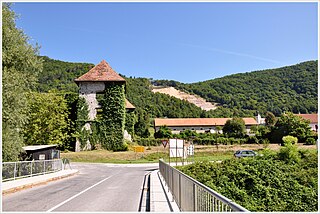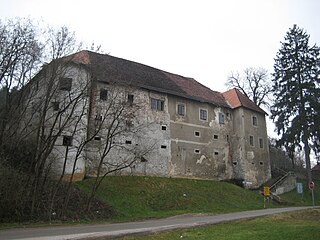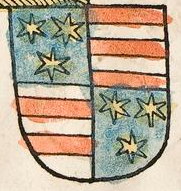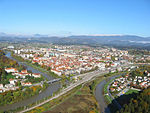
Celje is the fourth-largest city in Slovenia. It is a regional center of the traditional Slovenian region of Styria and the administrative seat of the City Municipality of Celje. The town of Celje is located below Upper Celje Castle at the confluence of the Savinja, Hudinja, Ložnica, and Voglajna rivers in the lower Savinja Valley, and at the crossing of the roads connecting Ljubljana, Maribor, Velenje, and the Central Sava Valley. It lies 238 m (781 ft) above mean sea level (MSL).

Gornji Grad is the largest settlement and the administrative centre of the Municipality of Gornji Grad in Slovenia.

Ulrich II, or Ulrich of Celje, was the last Princely Count of Celje. At the time of his death, he was captain general and de facto regent of Hungary, ban (governor) of Slavonia, Croatia and Dalmatia and feudal lord of vast areas in present-day Slovenia, Croatia, Bosnia, Austria, and Slovakia. He was also a claimant to the Bosnian throne. He was killed by agents of the Hunyadi clan under unknown circumstances, which plunged Hungary into civil unrest that was resolved a year later by the sudden death of king Ladislas the Posthumous and the election of Matthias Corvinus, the son of John Hunyadi and Ulrich's son-in-law, as king. Ulrich's possessions in the Holy Roman Empire were inherited by Emperor Frederick III, while his possessions in Hungary were reverted to the crown.

Samobor Castle is a ruined castle atop of Tepec hill in Samobor, Croatia. It lies only a 10-minute walk away from the city centre. Remains of the old castle moat are still visible, as well as the massive entrance and most of the walls.

The Maribor Water Tower is a medieval fortified tower in the city of Maribor, Slovenia. The late-Renaissance tower stands directly abuts the Drava River and dates from 1555. It is of pentagonal form and consists of massive stone blocks interspersed with embrasures. It was built to secure the southeast part of the Maribor city walls from the direction of the river.
Rupe is a small settlement in the City Municipality of Celje in eastern Slovenia. It lies in the hills on the northern outskirts of Celje. The area is part of the traditional region of Styria. It is now included with the rest of the municipality in the Savinja Statistical Region.

Slovenska Bistrica Castle, also known as Bistrica Castle, is a Renaissance-Baroque palace outside the town of Slovenska Bistrica in northeastern Slovenia. Its name derives from the Slovene word bistra 'clear'.

Vipava Castle is a castle ruin above the town of Vipava in the Municipality of Vipava in southwestern Slovenia.

Polhov Gradec Castle is a castle ruin above the settlement of Polhov Gradec, in the Municipality of Dobrova–Polhov Gradec in central Slovenia. It is located on Calvary Hill immediately northwest of the town center.
Association of Municipalities and Towns of Slovenia (SOS) was established in 1992 and is the biggest representative association of the municipalities of Slovenia. The association has 167 member municipalities and with this it covers nearly 90% of the inhabitants of Slovenia.

Soteska is a settlement on the left bank of the Krka River in the Municipality of Dolenjske Toplice in Slovenia. The area is part of the historical region of Lower Carniola. The municipality is now included in the Southeast Slovenia Statistical Region. Soteska includes the hamlet of Ključ southeast of the main settlement.

Čušperk is a village in the Municipality of Grosuplje in central Slovenia. It lies in the hills south of Grosuplje in the historical region of Lower Carniola. The municipality is now included in the Central Slovenia Statistical Region.

Trebnje Castle is a smaller castle located in a Slovenian town Trebnje, positioned on a plateau on the right bank of river Temenica. Sources claim that the castle was built around year 1000, which makes it one of the oldest Slovenian castles.[1]
Hermann I, Count of Celje, was a Styrian nobleman, who was head of the House of Celje between 1359 and 1385. In the first decade, he ruled together with his older brother Ulrich. After Ulrich's death, Hermann took over the custody of his nephew William and ruled as the de facto head of the family. Under his rule, the House of Celje began expanding its influence from its power base in present-day Slovenia and southern Carinthia to Central Europe and the Balkans. By marriage to the Bosnian princess Catherine, whose exact parentage is disputed, Hermann became the brother-in-law either of the Hungarian and Polish king Louis the Great, or of the Bosnian king Tvrtko I. His son Hermann II further expanded the family's wealth and influence. By the time of his death, Hermann I was the largest landowner in the territory of present-day Slovenia, where his possessions significantly outnumbered those of his Habsburg liege lords.

Frederick I of Celje, also Frederick I of Cilli, was a Styrian free noble who became the first Count of Celje, founding a noble house that would dominate Slovenian and Croatian history in the first half of the 15th century.

William of Celje, also William of Cilli, Count of Celje, was a Styrian nobleman who was married to Anna of Poland, daughter of the Polish king Casimir the Great. He was the co-ruler of the House of Celje together with his uncle Hermann I until 1385 and then with his cousin Hermann II until his death. William's only daughter, Anna of Celje, married the Polish King Władysław II Jagiełło in order to strengthen his claim to the Polish throne.

Ulrich of Sanneck, Lord of Žovnek, was a free noble in the March of Savinja in what was then the Holy Roman Empire and is now in Slovenia. During the struggle between Henry, Duke of Carinthia and the Habsburg rulers of Austria and Styria, he sided with the latter. By accepting the Habsburgs as his liege lords, he was instrumental in transferring the lordship over the Savinja region from the Meinhardiner-dominated Carniola to Habsburg Styria. His second marriage with the noblewoman Catherine of Heunburg would enable their son to claim the Heunburg inheritance in Carinthia and in the Savinja Valley, including the strategically important Celje Castle. This union of the Sanneck (Žovnek) and Heunburg (Vovbre) noble houses would give birth to the House of Celje.

Elizabeth of Frankopan, was the first wife of Frederick II of Celje, son and heir to Count Hermann II, Ban of Slavonia. By virtue of her marriage, she became the sister-in-law of the Hungarian Queen Barbara of Celje. Her marriage was troubled by disagreements with her husband, and in 1422 or 1423 she was found killed in her bed. The main suspect for the murder was her husband, who later married Veronika of Desenice, a woman of humble origin. The affair deteriorated the relations between the Houses of Celje and Frankopan, and led to a long-lasting feud between Elizabeth widower Frederick and her cousin Ivan of Frankopan. In the 19th and 20th century, Elizabeth's fate became the source of many literary and artistic adaptations in Slovenian, Croatian, and Hungarian culture.

Cmurek Castle is a castle in Trate, Slovenia. It stands on a steep cliff above the bridge over the Mura River at Trate, the international border crossing to the Austrian village of Mureck.




















